 |
Greenbelt MD (SPX) Jul 29, 2009 The latest Geostationary Operational Environmental Satellite, GOES-14, provided its first visible full disk image of Earth on July 27, at 2:00 p.m. EDT. The prime instrument on GOES, called the Imager, is taking images of Earth with a 1 kilometer (km) or 0.62 mile resolution from an altitude of 36,000 km (22,240 miles) above Earth's surface, equivalent to taking a picture of a dime from a distance of seven football fields. "The first GOES-14 visible full disk image shows little activity in the Atlantic Ocean and two tropical waves located in the East Pacific Ocean with a low probability of becoming a tropical cyclone. Numerous thunderstorms are seen scattered along the east coast and western Atlantic Ocean, with more significant rains and thunderstorms in the southeast Oklahoma and northeast Texas area," remarked Thomas Renkevens, a User Services Coordinator from the National Oceanic and Atmospheric Administration's (NOAA) National Environmental Satellite, Data and Information Service, Camp Springs, Md. "NOAA will continue to follow the tropical waves and thunderstorms for possible further development." The GOES satellite system aids forecasters in locating severe weather events and is instrumental in providing early warnings for residents located in the surrounding areas. "Being able to predict the path of a hurricane with reasonable certainty and only evacuating the areas at risk saves communities roughly a million dollars per mile," Renkevens stated. "This GOES-14 image also shows a mostly cloud-free southwest United States, with a blanket of low clouds along over the Pacific Ocean off the west coast," stated Renkevens. The Imager was built by ITT Industries, Inc. in Fort Wayne, Ind. The Imager is mounted on an ultra-stable optical bench on a spacecraft built by Boeing Space and Intelligence Systems of El Segundo, Calif. Star trackers on the spacecraft provide the attitude reference in order to point the instruments and keep the images jitter-free. "Capturing this first sharp image is a major milestone for our GOES team. It represents a culmination of this team's hard work and dedication. We still have more to do but full mission success is clearly in our sights," stated Andre' Dress, the NASA GOES N Series Deputy Project Manager, at NASA Goddard Space Flight Center, Greenbelt, Md. Launched as GOES-O on June 27, 2009, the satellite was renamed GOES-14 after reaching geostationary orbit on July 8, 2009. The satellite is now approximately 22,300 miles above Earth's surface located at 89.5 west longitude where it will remain during the 5 month checkout period. Boeing Space and Intelligence Systems handed over engineering control of GOES-14 to NASA on July 18, at the NOAA Satellite Operations Facility in Suitland, Md. On August 14, NASA plans to deploy the Imager and Sounder cooler doors that will allow the infrared detectors to take infrared images of Earth and soundings of atmospheric temperatures and water vapor levels. The Imager and Sounder data are also used for sea surface temperatures, fog and fire detection, volcanic eruption monitoring, and severe storm evaluations. NASA expects to complete checkout of the satellite by mid-December and hand it over to NOAA for operational use. NOAA expects to store GOES-14 on-orbit at 105 west longitude until an operational need arises. NOAA also expects to deorbit GOES-10 within the next six months due to fuel depletion. NOAA manages the GOES program, establishes requirements, provides all funding and distributes the environmental satellite data for the United States. NASA Goddard procures and manages the design, development and launch of the satellites and provides some ground station components for NOAA. Boeing Space and Intelligence Systems built GOES-O and provided the commercial launch services through Boeing Launch Services and the United Launch Alliance. Share This Article With Planet Earth
Related Links GOES-O/14 mission Earth Observation News - Suppiliers, Technology and Application
 TerraSAR-X Image Of The Month: Ship ID In Kiel Fjord And Baltic Sea
TerraSAR-X Image Of The Month: Ship ID In Kiel Fjord And Baltic SeaBonn, Germany (SPX) Jul 28, 2009 This image - from the German TerraSAR-X radar satellite - shows the city of Kiel and the Kiel Fjord, an approximately 17-km long fjord or firth of the Baltic Sea on the northeastern shore of Schleswig-Holstein. The ships that were in this area at the time the image was captured are each marked with a circle. The high resolution of TerraSAR-X images makes them ideally suitable for the rapid ... read more |
|
| The content herein, unless otherwise known to be public domain, are Copyright 1995-2009 - SpaceDaily. AFP and UPI Wire Stories are copyright Agence France-Presse and United Press International. ESA Portal Reports are copyright European Space Agency. All NASA sourced material is public domain. Additional copyrights may apply in whole or part to other bona fide parties. Advertising does not imply endorsement,agreement or approval of any opinions, statements or information provided by SpaceDaily on any Web page published or hosted by SpaceDaily. Privacy Statement |